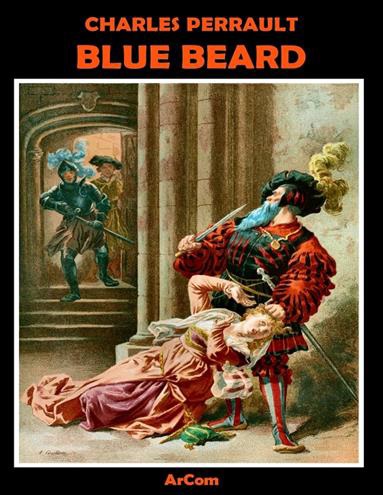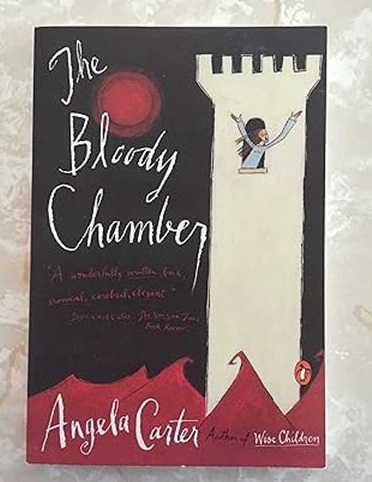
|
Masterand Teodor Vintilă Barbe Bleue - from Charles Perrault to Angela Carter Rating: ★★★★★ (5/5) |
|

Charles Perrault – Blue Beard, illustrated edition, published 2019

Angela Carter – The Bloody Chamber and other stories, 1990 edition
| |
|
The story of Bluebeard continues to hold literary and cultural relevance across time, space, and generations. From the original moralizing tone in Charles Perrault’s version to Angela Carter’s bold and symbolic rewriting, the tale of Bluebeard has undergone a fascinating transformation. Its durability lies not only in the plot but in the universal questions it raises – about power, curiosity, fear, and the fine line between innocence and danger. Thus, the story becomes a mirror in which each era recognizes its own anxieties, values, and struggles. From ancient myths to postmodern symbolism, the key elements of this story can be identified in almost any work of art that addresses different aspects of gender relations and the dynamics of power that sustain them, both within and outside the institution of marriage. By analyzing this story across authors and centuries, the conclusion becomes clear: myths, legends, and old fairy tales are far from outdated. They continue to serve as cultural reference points, narrative molds, and tools for self-exploration. Their reimagining in modern literature is not a form of literary nostalgia, but an act of reinvention – a way to ensure their presence in the ever-changing discourse of literature and society. At first glance, Bluebeard seems like a simple fairy tale: a mysterious husband, a curious wife, a forbidden room, and a cruel punishment. However, beyond this seemingly banal structure lie deep symbols and universal themes related to fear, curiosity, power, identity, and freedom. Over time, this story has been reinterpreted and adapted according to the sensitivities of the era and its audience. In this comparative review, I aimed to analyze two essential versions of the story: the classic one written by Charles Perrault at the end of the 17th century, and the modern reinterpretation offered by Angela Carter in the 20th century, in the volume The Bloody Chamber. Although they share a common narrative core, the two versions express radically different worldviews shaped by the historical, ideological, and cultural contexts of their authors. Thus, the story becomes a space for reflection on the role of women, knowledge, and power relations. The classic version by Charles Perrault is short, straightforward, and strongly moralizing. The character Bluebeard is a frightening man, extremely wealthy, but avoided by everyone because of his unusual appearance. It is said that he had several wives, but no one knows for certain what happened to them. When a young woman agrees to marry him, she is put to the test: she receives all the keys to the house, but is strictly forbidden to enter a certain room. Curiosity drives her to break the rule and she discovers a chamber of horrors, containing the corpses of Bluebeard’s former wives. This discovery draws Bluebeard’s wrath upon her, and he intends to kill her, but her brothers arrive in time to save her. On the surface, this story can be interpreted as a warning against curiosity and disobedience to authority. Perrault concludes the text with an explicit moral, emphasizing that curious women are punished, and obedience is a virtue. Beneath the surface, the tale reflects the patriarchal structure of the society of its time: the man holds power, sets rules, and administers punishments, while the woman is passive, dependent, and vulnerable. Her rescue does not come through her own strength but through male intervention, reinforcing the idea that a woman must be protected and guided, not empowered. In contrast, Angela Carter’s reinterpretation in The Bloody Chamber is much more complex, dense, and symbolic. The story is narrated by the young bride herself, which offers an intimate, profound, and reflective point of view. This narrative choice transforms the entire dynamic of the text: instead of being a passive object in her husband’s hands, the protagonist becomes an active subject of her own story. Bluebeard is no longer just a man with frightening features, but a symbol of seduction, psychological control, and a fascination with death. In this version, the forbidden chamber is not just a physical space but a place of brutal truth, hidden violence, and confrontation with reality. The young woman is not merely curious; she undergoes a true initiation – a journey inward from innocence to awareness. The story’s ending completely reverses the roles: the woman is no longer saved by her brothers but by her own mother, who arrives mounted and armed. This symbolic reversal suggests that women can defend one another, that female solidarity is possible, and that motherhood means not only gentleness but also strength, courage, and active protection. In both stories, curiosity drives the action. In Perrault’s tale, it is a sin, a mistake to be punished. In Carter’s, it is a necessary stage on the path toward knowledge and freedom. This difference marks a major shift in paradigm: whereas in the seventeenth century control and obedience were valued, in the twentieth century emancipation and self-awareness become essential landmarks. Power is another central element. In Perrault’s version, it is absolute, masculine, and authoritarian. The woman has only two options: to submit or to die. In Carter’s version, power is more nuanced. Although initially in the hands of the man, the power is gradually taken over by the woman, who learns to understand, resist, and ultimately act. Help comes from another woman – her mother – which breaks the tradition of classic fairy tales and adds a feminist perspective on rescue. The forbidden chamber is also an ambivalent symbol. It can be seen as a metaphor for hidden trauma, but also as the space where truth takes shape. It is the “Pandora’s box” of the fairy tale: opening it causes crisis, but also transformation. Without this moment of breaking the taboo, there would be neither revelation nor liberation. In this sense, the chamber also becomes a space of maturity, self-discovery, and confrontation with evil. Charles Perrault writes in an accessible style, with short sentences, a fast pace, and an explicit morality. His text approaches orality, making it easy to transmit and understand, especially for children. His purpose is clearly educational: to offer behavioral models and moral warnings. Angela Carter, on the other hand, writes in a poetic register, with elaborate sentences, powerful metaphors, and rich sensory descriptions. Her text requires careful, reflective reading, aimed at an adult reader capable of grasping nuances and symbols. Thus, the story becomes not only a narrative act but also a philosophical and psychological exploration of the human condition and femininity. Comparing the two versions, we see how the same story can be rewritten to reflect very different values and ideas. Bluebeard is more than just a fairy tale; it is a cultural palimpsest. Charles Perrault reflects a world where the woman must submit, and the man has the right of life and death. Angela Carter, on the other hand, proposes a liberating vision: the woman confronts evil, understands it, and overcomes it – not through submission, but through awareness and action. Thus, the story of Bluebeard becomes a living example of how literature can evolve and speak differently to each generation. It shows us how we can move from fear to trust, from ignorance to knowledge, from submission to freedom. Depending on who tells it, how it is told, and to whom it is addressed, a story changes its meaning, and Bluebeard remains, essentially, a mirror of the human soul, of the desire to know and to be free. The universality of the Bluebeard myth endures precisely because it addresses fundamental human concerns: the fear of the unknown, the fascination with the forbidden, the attraction to danger, and the inner struggle between reason and emotion. In any era, the reader recognizes themselves in the tension of this story – a tension that reflects the conflict between authority and freedom, between submission and autonomy, between what we are told to be and what we truly want to be. By analyzing the two versions of the Bluebeard story, I realized how strongly the author’s
context and perspective can influence the message conveyed. The classic version impressed me
with its simplicity and moral clarity, while the modern reinterpretation made me reflect more
deeply on social roles and on how stories can be adapted to address contemporary issues. For
me, this comparison was a lesson in how alive and flexible literature can be, but also in the
importance of a critical perspective on old texts. References Carter, A. (1990). The Bloody Chamber and other stories. Penguin Books Ltd. (Original work published 1979). Perrault, C. (2019). Blue Beard (M. Wright, Trans.; A. Lang, Intro.; J. E. Southall, Illus.). Fabio Ardizzone. (Original work published 1697 as La Barbe Bleue).
|
|

